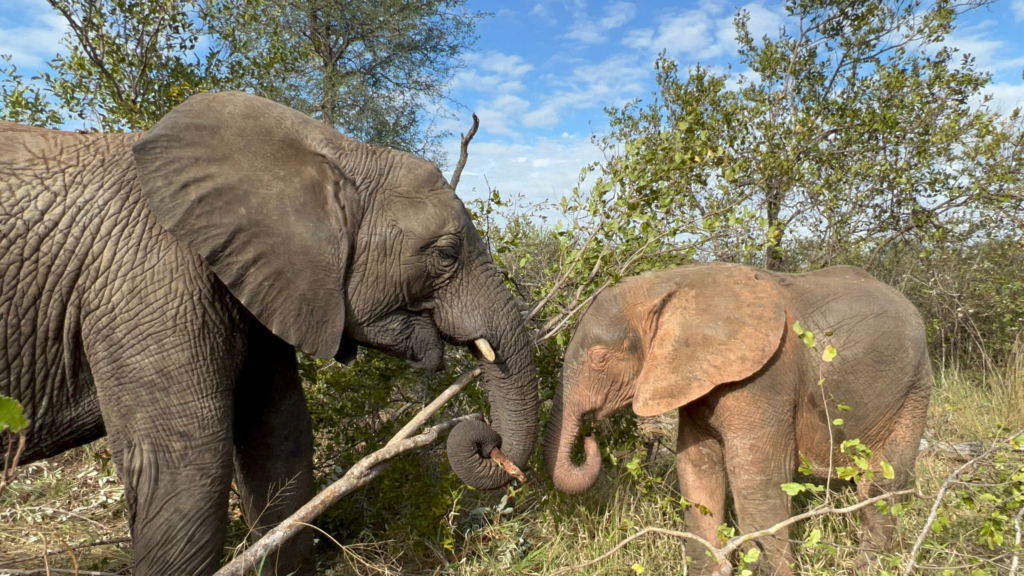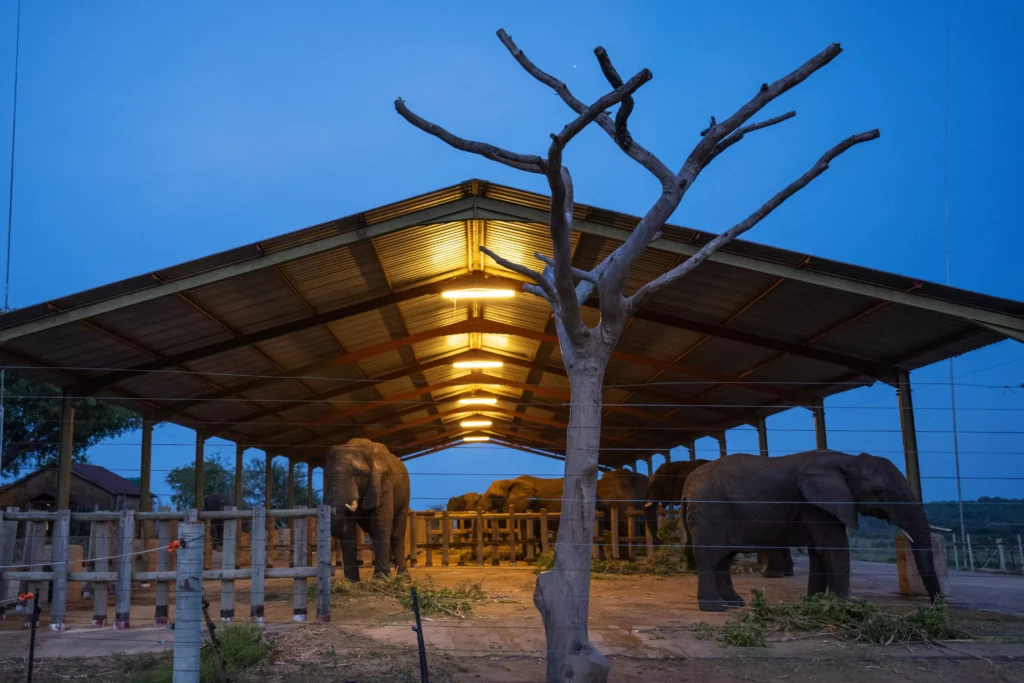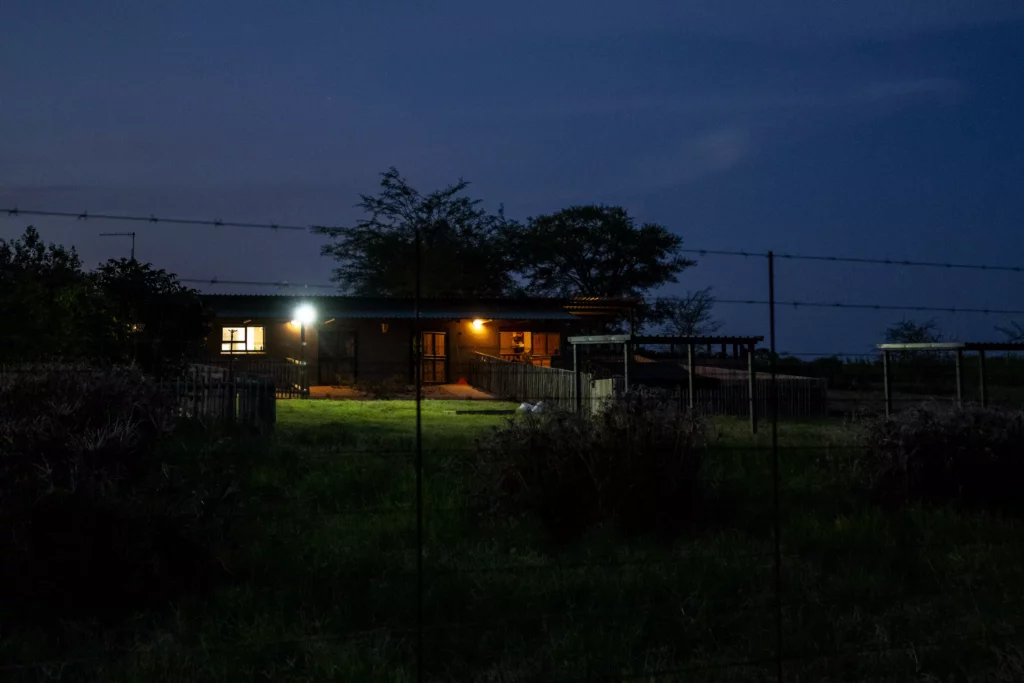Eternal Sunshine for the Elephants
Just before darkness falls over the bush, the Jabulani herd passes the last waterhole on their day’s journey and arrives at their homestead. Khanyisa, the albino four-year-old snare survivor who has fully integrated into the herd, drinks her last milk bottle before heading in with the other elephants.
The last of the sun’s glow slips away and the lights in the homestead illuminate the gentle giants eating beneath them. Some of the elephants move down into the garden — you can hardly see their bodies on an overcast night or when the moon is but a sliver in the sky. Around them are hectares of wilderness with the nocturnal animals of the bush stirring as hunting hour arrives. The fencing around the homestead keeps unwanted visitors out, not only the predators roaming, but also wild elephants that may try to challenge our herd.
This is a safe space, where the elephants know they can rest after their day in the wild. It’s where the carers know their herd is together and out of harm’s way. The men who walk with the elephants sleep in accommodation alongside the homestead, with ears alert to any trumpeting or sounds of trouble in the night. This is a time of peace. But the elephants don’t sleep right though. Mambo can’t resist sparring with Jabulani in their section of the stables. Khanyisa frequently engages Timisa in playful scuffles.

Without power, the carers can’t turn on their lights to see the elephants in the night when there is a rumble and tumble louder than normal. The electric fencing keeping the elephants protected switches off. We can’t charge our radios, phones and spotlights. Our communication channels are cut, our eyes at night blinded.
We felt this intensely when Tokwe went missing and the search for her continued through the pitch black night. Our radios and spotlights were too old and insufficient for the job at hand. We needed torches that would light up the bush for a large distance as we searched for the missing matriarch. We needed reliable communications as the team split up for the mission. With predators like lion and leopard out at night, we needed extra light to keep us alert and safe.
This is why poachers head into the bush at full moon to carry out their stealthy criminal operations, using nature’s light to their advantage while not being seen. In the orphanage at night, no electricity means we can’t make orphans like little Phabeni milk bottles, which he needs around the clock. We are open to threats like roaming leopard without electric fencing. We can’t provide extra warmth through heat lamps on freezing cold nights or relief from a fan on hot summer nights. We can’t see. So we turn on the diesel generators, which stresses elephants like Khanyisa, with the loud whirring sound, and when the generators break, we’re back to square one.
During the day, electricity is just as essential. As we mix the formula and heat water for milk bottles, irrigate our bana grass plantations for the elephants, pump drinking water, charge our devices, operate machinery in the warehouse, wash the elephant homestead with the pressure washer, feed our staff.
The energy crisis in South Africa isn’t something a lot of people in other parts of the world understand. The sole public electrical utility in South Africa is Eskom, and it supplies 95% of the country’s electricity. To prevent overloading the national power grid when energy demand exceeds production, forced blackouts are implemented. This is known as load-shedding and it occurs across South Africa in various stages. It has been our reality since 2007.
The typical American is said to experience fewer than 10 hours of power outages a year – whereas in South Africa, we frequently experience more than 10 hours of power outages in one weekend. This makes running an elephant orphanage very difficult.
The use of solar energy is the most readily accessible resource in South Africa, with the sun shining brightly over many parts of the country all year round. Hoedspruit, where HERD is based, receives excellent sunlight in winter and summer. Making use of this more sustainable and reliable source of electricity in our remote wilderness has multiple benefits, such as reduced electricity costs in the long-run, energy independence, reliability and durability, a more environmentally-friendly footprint, reduced maintenance needs, and being prepared for any potential power catastrophe, as stages 6 and up become a reality.
For the sake of our elephants and our environment, we have decided to take HERD off the grid. It is an expensive move, but only at first. After a year, we will be seeing a return on investment and have much lower energy costs. It is an investment that is far more sustainable for the long-term care of the herd and their carers, and it is always sustainability that drives and directs our decision-making. We are excited for this new stage of being a solar-powered elephant orphanage and homestead, able to better protect and reliably provide for all the elephants at HERD, plus any new orphans that might need our help (and any matriarchs that decide to go walkabout in the night).
Please consider supporting our SOLAR CAMPAIGN by donating a RAY OF SUNSHINE to HERD. No donation is too small. DONATE HERE >




 Comment
Comment








How do I increase my current monthly donation for Phabeni? Just saw your post about adopting an elephant and think I adopted him with my original monthly donation, but not sure. Thanks.